8 Fruits and Vegetables You Didn't Know You Could Freeze
Save food and speed up meal prep by freezing these fruits and vegetables.
The freezer is a crucial tool for any home cook, whether you're trying to reduce food waste or get ahead with meal prep. It prevents the growth of harmful microbes, allowing you to preserve food for a long time—and ultimately, keep it safe for a later date. Freezing is especially helpful for extending the shelf-life of fruits and vegetables, which are highly perishable.
Some produce, like bananas and carrots, are well-known foods you can freeze. But why stop there? With the right technique, you can save more food than you think, as proven by these unexpected fruits and vegetables that can be stored in the freezer.
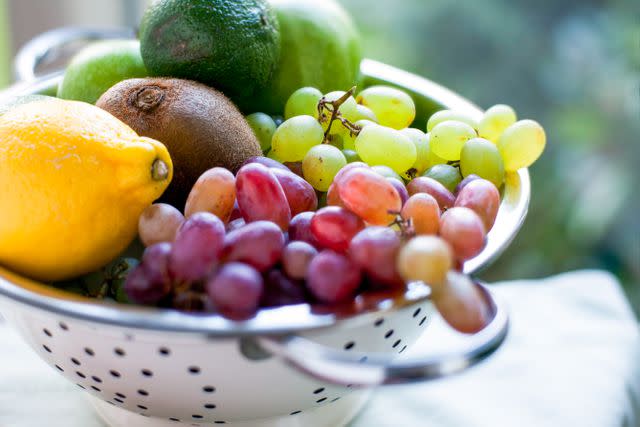
cheche22 / GETTY IMAGES
Related: 9 Ingredients You Didn't Know You Could Store in Your Freezer—Including Eggs and Leftover Wine
Cucumbers
Due to their high water content, cucumbers are often thought to be unsuitable for freezing, but it depends on how they're used. Frozen cucumbers will not be as crisp when defrosted, but can still be used in recipes where the crispness isn’t as important, think gazpacho, tzatziki, sorbet, popsicles, or chilled cucumber soup, says Olivia Roszkowski, chef-instructor at the Institute of Culinary Education.
How to Freeze Cucumbers
Roszkowski suggest this method for freezing cucumbers:
Cut into 1/4-inch slices and spread in a single layer on a parchment-lined baking sheet.
Place in the freezer for 30 to 60 minutes, or until frozen.
Transfer frozen cucumber slices into an airtight container or bag,
Related: How to Freeze Cucumbers the Right Way
Zucchini
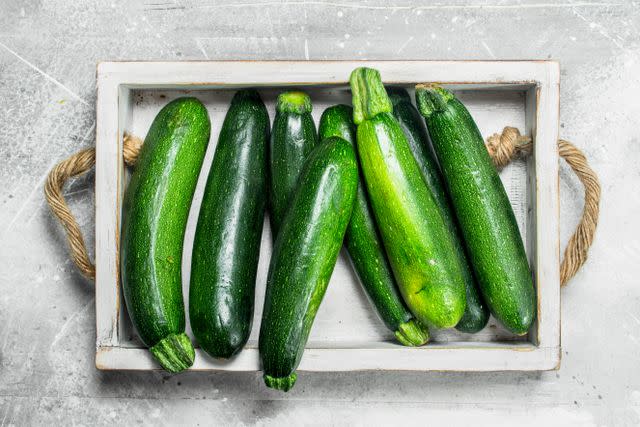
Olesia Shadrina / GETTY IMAGES
Like its relative cucumber, zucchini is also rich in water—so you might be surprised to learn it can be frozen too. According to Roszkowski, briefly blanching zucchini before freezing can help maintain its integrity when it thaws.
Use frozen zucchini for recipes such as zucchini bread, latkes, smoothies, homemade crackers, soups, fillings for dumplings or spanakopita, or even dips, spreads, and sauces, says Roszkowski.
How to Freeze Zucchini
This method includes blanching zucchini before freezing.
Bring a pot of water to a boil, then place diced or sliced zucchini in the pot and cook for 20 to 30 seconds.
Strain the zucchini and transfer to an ice bath.
Dry zucchini with paper towel and arrange the pieces in a single layer on a parchment-lined baking sheet.
Freeze for one hour before transferring to a freezer-safe airtight container or freezer bag.
You can also use this method for grated zucchini.
Avocado
Unless you follow the right storage technique, cut avocados are notoriously difficult to store, but that doesn't mean they're not freezer-friendly. Since frozen avocados can become very mushy when thawed, Roszkowski advises against using defrosted avocado as a topping for soups or salads. Instead, avocado that has been frozen is best for recipes where its texture isn't center stage, including smoothies, savory chilled soups, and as binders for chocolate cake, says Roszkowski. "Guacamole can be okay in a pinch as long as there are other ingredients like tomato, onion, cilantro, lime, and jalapeño to enhance the flavor and texture," she says.
How to Freeze Avocados
Peel and dice the avocados.
Arrange them in a single layer on a parchment-lined baking sheet.
Freeze for one hour before transferring them to a freezer-safe container or freezer bag.
Citrus Fruits
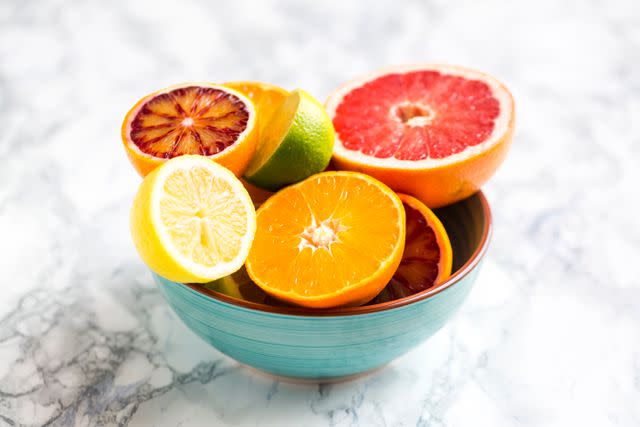
Westend61 / GETTY IMAGES
As citrus fruits aren't sold in the frozen section of supermarkets, many people are unaware that they're a food you can freeze. This includes juicy favorites like oranges, lemons, and grapefruits. Once defrosted, citrus fruit will be slightly mushy, but the juice can still be used, says Traci Weintraub, chef and founder of Gracefully Fed, a restaurant in Los Angeles. With that in mind, use frozen citrus in recipes such as lemonade, smoothies, milkshakes, pureed sauces, or homemade sherbet.
How to Freeze Citrus
Peel and cut the fruit into wedges. (Wedges freeze better than slices.)
Arrange wedges on a parchment-lined baking sheet, freeze until solid, and place them in a freezer-safe bag.
Related: These Are the 6 Foods You Should Always Have in Your Freezer, According to Chefs
Onions
They're a foundational ingredient in almost every recipe, so it's worth keeping onions in your freezer. To freeze onions—and avoid an onion smell in your freezer—start by sharpening your knife. This will create a cleaner cut and avoid crushing onion cells, which will otherwise release volatile (read: smelly) gasses, says Roszkowski. You can further minimize the odor by refrigerating the onions before cutting.
If possible, only cut the onion as much as needed and keep pieces larger to reduce the smell, says Roszkowski.
How to Freeze Onions
Spread onion pieces in a single layer on a parchment-lined baking sheet.
Freeze till firm, transfer pieces to a freezer-safe airtight container or freezer bag.
Grapes
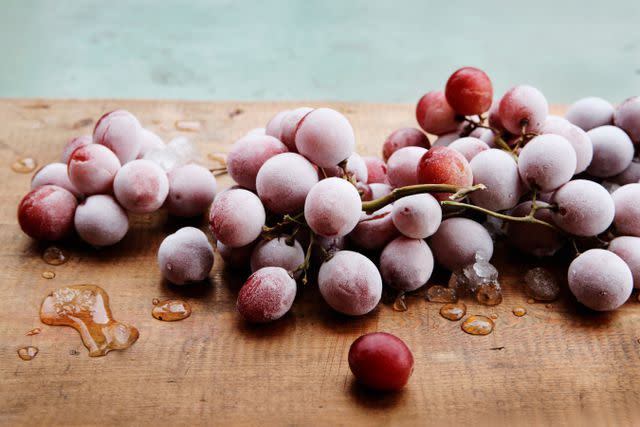
Carmen Troesser / GETTY IMAGES
"Grapes taste delicious when frozen," says Roszkowski. You can enjoy the frozen juicy orbs straight out of the freezer (a satisfying treat on hot days) or place frozen grapes in a blender to create a quick grape sorbet, says Roszkowski. You can also use frozen grapes in place of frozen blueberries in muffin or pancake batters, or turn frozen grapes into jam, jelly, or marmalade, she says.
How to Freeze Grapes
Remove them from their stems, rinse well, and pat dry.
Arrange on a parchment-lined baking sheet to freeze until firm, then transfer to a freezer-safe container or freezer bag.
Chile Peppers
Did you know that it's possible to store chile peppers in the freezer? Weintraub says frozen chile peppers are excellent additions to sauce or pesto.
How to Freeze Chile Peppers
To freeze chile peppers without their skins:
Blister them in the broiler, grill, or on the stovetop for about five minutes or until the skin is easily removed, per the experts at Michigan State University.
Freeze them in a single layer on a parchment-lined baking sheet, then transfer them to a freezer-safe container or freezer bag.
To keep the skin on, skip the blistering step and freeze them on a parchment-lined baking sheet.
Garlic
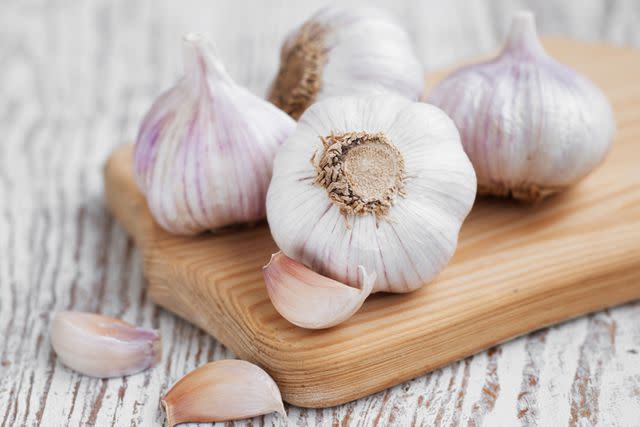
Ls9907 / GETTY IMAGES
Like onion, garlic is a base ingredient in many recipes, so freezing it is a great time-saving move.
How to Freeze Garlic
Peel fresh garlic cloves and mince them in a food processor.
Freeze the minced garlic in ice cube trays reserved for this use. (Do not use the ice cube trays for ice after you have used them for garlic.)
Freezing garlic in ice cube trays means you can portion it out for daily use, notes Weintraub. Add frozen garlic cubes directly to sauces, stews, and soups. For reference, "three cloves of garlic [equal] about one tablespoon or cube," says Weintraub.

